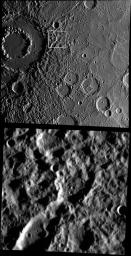These images highlight the spectacular Vivaldi peak-ring basin and its ejecta blanket. The top image was acquired with MESSENGER's Wide Angle Camera, and the white box shows the location of the bottom image, acquired about a minute later with the Narrow Angle Camera. While Vivaldi is stunning, the real purpose of these images was to check and improve the geometric calibration of the cameras. As light passes through the lenses of a camera, it bends such that subtle geometric distortions of the scene occur, and for the Wide Angle Camera things like the focal length can shift by small amounts depending on which filter is being used. These images were part of a series that is designed to make sure we can map each pixel of the NAC and WAC to a geographic latitude and longitude as accurately as possible, and that the coordinates from the two cameras match perfectly. The two images shown here are also a good reminder of just how much higher resolution the NAC provides compared to the WAC.
Date acquired: July 29, 2014
Image Mission Elapsed Time (MET): 48972719, 48972797
Image ID: 6774306, 6774309
Instrument: Wide Angle Camera (WAC) and Narrow Angle Camera (NAC) of the Mercury Dual Imaging System (MDIS)
Center Latitude: 12.08°
Center Longitude: 278.1° E
Resolution: 57 and 426 meters/pixel
Scale: Vivaldi is approximately 213 km (132 miles) in diameter
Incidence Angle: 82.2°
Emission Angle: 14.3°
Phase Angle: 96.5°
The MESSENGER spacecraft is the first ever to orbit the planet Mercury, and the spacecraft's seven scientific instruments and radio science investigation are unraveling the history and evolution of the Solar System's innermost planet. During the first two years of orbital operations, MESSENGER acquired over 150,000 images and extensive other data sets. MESSENGER is capable of continuing orbital operations until early 2015.
For information regarding the use of images, see the MESSENGER image use policy.

 Planetary Data System
Planetary Data System












